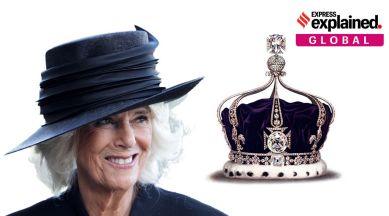Queen Consort Camilla, and the Kohinoor in her crown
According to reports, King Charles III's wife Camilla will wear the crown with the Kohinoor diamond as the new Queen Consort.

With the death of Queen Elizabeth II in the United Kingdom on September 8, King Charles III has been proclaimed the monarch. The formal coronation ceremony will see him wear the Imperial State Crown for the first time. While no date has been announced for it yet, what is known is that several of the other Crown Jewels will be a part of the ceremony, and the Kohinoor diamond will also be seen.
Who does the Kohinoor go to?
The Kohinoor diamond was embedded in the crown of Queen Elizabeth’s mother, Queen Elizabeth I, for the coronation ceremony of her husband King George VI in 1937. She wore it again during her daughter’s coronation in 1953. During her funeral procession in 2002, it was placed atop her coffin.
The crown has been worn by her as the Queen Consort — the person who is married to the King but is not a queen through the line of succession. According to reports in the British media, Charles’s wife Camilla will wear it next as the new Queen Consort. The Queen Consort is usually “crowned with the King, in a similar but simpler ceremony”, according to the royal family’s website.
How did the Kohinoor diamond reach Britain’s royals?
Famed as a shiny, big diamond, the Kohinoor, Persian for ‘Mountain of Light’, is counted among the largest precious stones in the world. There is some disagreement over where and when it was mined, but it is generally believed to have its origins in India, in the Golconda mines of present-day Andhra Pradesh and Telangana.
Since its discovery, the stone has moved from king to king. It was placed on the Mughal Emperor Shah Jahan’s famous Peacock Throne at the Red Fort in Delhi in the 17th century, and a contemporary Mughal source gives the following description of the throne:
“The outside of the canopy was to be of enamel work studded with gems, the inside was to be thickly set with rubies, garnets, and other jewels, and it was to be supported by emerald columns. On top of each pillar there were to be two peacocks thick set with gems, and between each of the two peacocks a tree set with rubies and diamonds, emeralds and pearls.”
Following the invasions of Iranian ruler Nadir Shah, the Kohinoor was taken away from India, and it finally reached the Afghan invader Ahmad Shah Durrani. In the 19th century, it went to Maharaja Ranjit Singh, the founder of the Sikh empire, who had his capital in Lahore. After the Second Anglo-Sikh War of 1849, the kingdom of Punjab was annexed by the East India Company, and the child king Duleep Singh was forced to give up the diamond to Queen Victoria.
The movement of the diamond through its history has made the claims for its return contentious. Afghanistan and Pakistan, as well as India, have at various points demanded it from the British government.